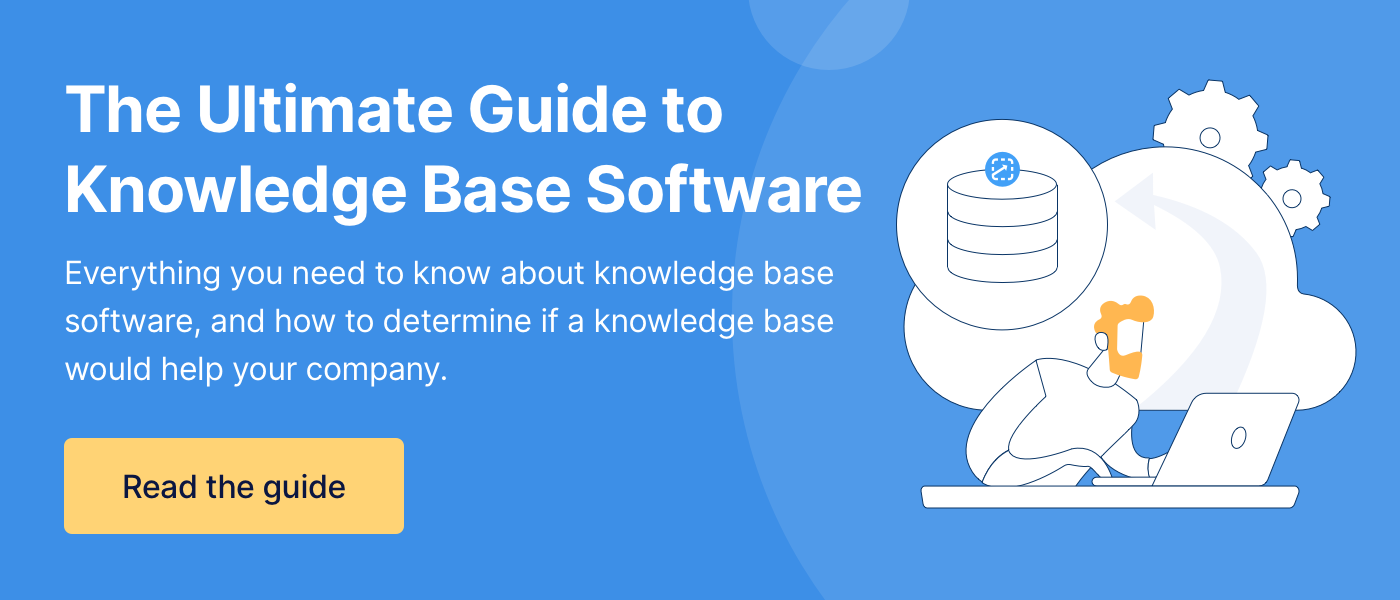How to Choose Call Flow Software For Your Call Center (6 Factors)
You know that call flows are important to support your call center agents. Maybe you haven’t had success with them in the past, but you are willing to give call flows another try.
So, now you are looking for software that will help you write clearer call flows. (And, you’re hoping you can find one that makes it faster to create call flows and easier to use them.)
But, what do you really need in your call flow software? There are so many options out there. It’s hard to choose which to use.
As someone who spends more time scrolling through Netflix trying to decide what to watch than actually watching shows, I get it. Decision fatigue is hard and committing to software is difficult.
Working for ScreenSteps — a knowledge base software company with workflow articles for writing call flows — I recognize that a knowledge base is only one option out there. And not every call center needs something as advanced as a knowledge base for documenting call flows.
So, my goal in this blog post is to provide you with six factors to consider before choosing a call flow tool to help you document your procedures in your call center.
In the end, you’ll know what to prepare before you begin your search for a call flow tool as well as what to look for in your search.
1. How will you use your call flows
Why are you documenting your call flows?
Before you spend time looking for call flow software, you’ll want to establish your purpose. After all, there is no point in buying new light bulbs for your light fixture if the real problem is the wiring is off.
Do you just need a way to prove you’ve written call flows, but you don’t expect your employees to use them?
The purpose of a call center call flow is to provide call center agents with instructions so that they can handle any call.
Ask yourself these questions:
- How detailed do your call flows need to be?
- What do your agents need?
- What is your goal (i.e. fewer mistakes, improve employee performance, etc.)?
Once you know what you want to accomplish as you write and share your new call flows, you can figure out the next steps.
🔍 Related: Call Center Script vs Call Flow: What Are They? When Should I Use Them?
2. Call flow presentation
There are different methods for documenting call flows. Some concentrate heavily on words, another option is more of a visual guide, while one option is more interactive.
Here are three different options for writing and designing your call flows:
I. Documents (manual style)
This is the most traditional call flow. Think of it as a call center manual. Just like reading a book, you write instructions from left to right.
Typically, these are written in Microsoft Word or Google Docs. They are heavy on words with step-by-step written instructions. They use indentations, bolding, and other text elements to help readers skim the page.
You can include screenshots to show agents where to click and what to do.
II. Flowchart
With flowcharts, you have a visual decision tree. Starting in the top-left corner, you present a scenario and branch off according to the possible next steps. You design these decision points by using different shapes, lines, and colors.
You can often export these flowcharts as images, PDFs, spreadsheets, or documents.
The downfall of a flowchart is you can’t use screenshots to show agents where to click or what to do.
Related: How to Make a Flowchart For Your Call Center Agents (5 Best Practices)
III. Workflow articles
An interactive workflow article is a step-by-step program that walks an agent through a call. The call flow presents questions. The agents click their answers to move to the next step of a procedure.
You can include screenshots, foldable sections for additional information, and other interactive elements in workflow articles.
Workflow articles are typically only included with a knowledge base or another software service that does more than documents call flows.
3. Tools & capabilities
Every call center software for call flows has its own tools and capabilities. Keeping in mind the purpose of your call flows and how you want to present your documents, decide on a list of tools and capabilities you need from your call flow software.
For example, if you are writing call flows in a basic written format, then you’ll want to make sure you have tools that highlight key steps (i.e. bolding, highlighting, indentations, etc.).
Whereas, if you are creating a flowchart for your call flows, you’ll want a program that has design elements that are easy to learn and lay out on a page.
Here are some of the tools and capabilities to think about:
Authoring tools
When it comes to creating call flows, your authoring tools are critical for writing clear and consistent documents that your agents can follow.
The table below shows you different tools to consider for each of the different design options for call flows.
|
Documents |
Flowcharts |
Workflow Articles |
|
|
|
Design flexibility
How much flexibility do you need for design?
When looking at call flow software, you’ll want to know how important design flexibility is. Some software companies limit the tools while others have a wide variety of design options.
Some companies keep their designs simple so that the information is clear, consistent, and it is easy for their agents to follow. Other companies like having the flexibility to design guides that focus on their branding and they want more design flexibility in order to do that.
Ease of use
Not all content creation tools are created equal. While some are complex and built for the advanced designer, others are intuitive and easy to learn.
Keep in mind how many people you will need to train on (1) writing the content and (2) reading the guides. How much training will it take?
Use this information to determine where ease of use falls into your qualifications for choosing a call center software service.
Permissions management
Who do you want writing call flows in your company? Do you want all of your agents to be able to see all of your call flows?
Each call flow tool has different capabilities when it comes to granting agents access to creating and viewing your call flows. If you need to limit access or set up roles, find out what the specific call flow software’s capabilities are.
Communication and notifications
Depending on the software you use, you can share the call flow with your team simply through a share option or a shared drive. Other documentation tools require you to notify team members about updates or the new call flow by sending a separate email or message.
4. Collaboration
Ideally, you’ll have a team of people working on writing your call flows. Not only do you want people to own specific procedures — making sure they stay up to date and accurate — but you need a second pair of eyes reviewing the work.
(Seriously, as a writer and editor, I attest — everybody needs an editor.)
Who will be creating your call flows? Will you need multiple people working on it at once?
Some call flow software options are cloud-based, which makes it easy to collaborate on a call flow. Multiple employees can write and provide feedback within the app.
With other options, collaboration is more complicated. It requires downloading the call flow, emailing it to your coworker, and then they can review it. That coworker then saves the edits as a new version of the document and sends it back.
5. Accessibility
How will you make your call flows accessible to your agents?
Writing your call flows is great, but what is the point if your agents can’t use them? Call flows help your call center agents avoid getting stuck while they are on a call.
Depending on the call flow software you choose, there are three options for making your call flows accessible for your agents.
I. Cloud-based software
Nowadays, most software programs are cloud-based. This means that you store your documented call flows in the cloud so that your agents can access them no matter where they are.
This requires all of your to have an account (or subscription) to the software that you choose.
II. Integrations
Depending on the software, the company may integrate with a variety of different applications. That means, if you use a document sharing drive, you may be able to automatically save or upload completed call flows to the drive.
Your call flows are instantly shared with your team when you are complete.
III. Document library or knowledge base
If the first two options aren’t available, then you may need an external shared drive. This could be in the form of a knowledge base or document library.
Using a document library or knowledge base, you can upload the call flow documents (i.e. PDF, spreadsheets, etc.) in your cloud base. The documents are stored, organized, and shared in the drive.
🔍 Related: 5 Tips For Choosing the Best Knowledge Base Software For Your Business
6. Budget
You knew this tip was coming, didn’t you? Of course, before you start your search, you need to know what your company can afford.
There is a wide range of pricing for call flow software. This can depend if you are only looking for something to write your call flows or if you also want a system to store, organize and share your call flows with your company (like a knowledge base, document library, or CRM).
How much is your company willing to spend on the content creation tool?
Companies charge for documentation software in different ways. Some have a monthly or annual subscription while others have a one-time purchase.
Most call flow software companies provide a free trial for a limited time. This helps take the pressure off of making a decision before you see if the software could work for you.
Ready to look at call flow software options for your call center?
Choosing the right call flow software for your call center can be overwhelming. When you pay attention to these six factors, it makes it easier for you to eliminate the software that isn’t the right fit for your business.
Then you can focus on the software options that could work for your company. Besides software dedicated to authoring call flows, another option is a knowledge base.
In a ScreenSteps knowledge base, you can quickly write call flows and share them. Call flows are immediately shared with your team when they are published. Agents can find the guides in as little as two clicks. Plus, they don’t need to put callers on hold to find answers.
Watch this 3-minute video to see how easy it is to author call flows in ScreenSteps workflow articles.
Not ready for knowledge base software yet? Are you considering writing call flows as flowcharts? Here are some of the best call flow software for writing flowcharts.




